

|
Astronomy 162:
Introduction to Stars, Galaxies, & the Universe
Prof. Richard Pogge, MTWThF 9:30
|
Lecture 16: The Evolution of Low-Mass Stars
Readings: h 21, sections 21-1 & 21-2, and
Ch 22, sections 22-1 to 22-4
- Low-Mass Star = M < 4 Msun
- Stages of Evolution of a Low-Mass star:
- Main Sequence star
- Red Giant star
- Horizontal Branch star
- Asymptotic Giant Branch star
- Planetary Nebula phase
- White Dwarf star
Main Sequence Phase
Energy Source: Hydrogen fusion in the core
What happens to the He created by H fusion?
- Core is too cool to ignite He fusion
- Slowly builds up an inert He core
Main-Sequence (H-burning) Lifetime:
- ~10 Gyr for a 1 Msun star (e.g., Sun)
- ~10 Tyr for a 0.1 Msun star (red dwarf)
Core Hydrogen Exhaustion
Inside:
- He core collapses & starts to heat up.
- H burning zone moves into a thin shell surrounding the core
- Collapsing core heats the H shell above it, driving the fusion
faster.
- More fusion = more heating, so that Pressure > Gravity
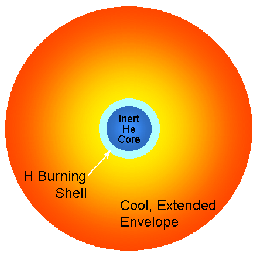
Outside:
- Envelope expands and cools
- Star gets brighter and redder & climbs up the
Giant Branch.
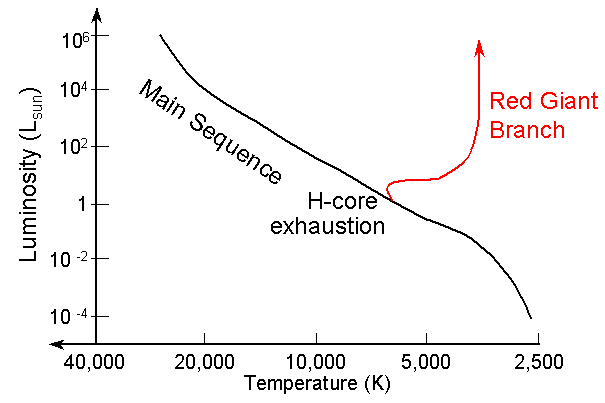
It takes a star about 1 Gyr to climb the Red Giant Branch
- He core contracting & heating, but no fusion
- H burning to He in a shell around the core
- Huge, puffy envelope ~ size of orbit of Venus
At the Tip of the Red Giant Branch:
- Tcore reaches 100 Million K
- Ignite He burning in the core in a flash.
At 100 Million K, a new fusion source ignites: the Triple-alpha Process.
This is the fusion of three 4He nuclei into one 12C
(carbon) nucleus:

A secondary reaction forms Oxygen from Carbon & Helium:

When this occurs, the star leaves the Giant Branch.
Inside:
- Starts generating primary energy from He burning in the core.
- Gets additional energy from an H burning shell surrounding the core.
Outside:
- Gets hotter and bluer.
- Star shrinks in radius, getting fainter.
The new energy source helps the star begin to regain Hydrostatic and
Thermal Equilibrium. As it does so, it moves onto the
Horizontal Branch.
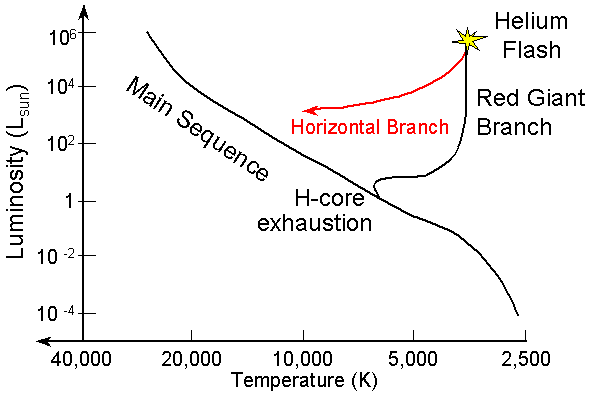
Structure:
- He-burning core
- H-burning shell
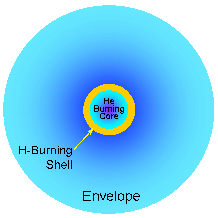
The Triple-alpha Process is very inefficient at producing energy, so it
can only last for about 100 Myr.
While it goes on, the star steadily builds up a C-O core, but it is
still too cool to ignite Carbon fusion
After 100 Myr, the core runs out of Helium for Triple-Alpha fusion.
Inside:
- C-O core collapses and heats up
- He burning shell outside the C-O core
- H burning shell outside the He burning shell
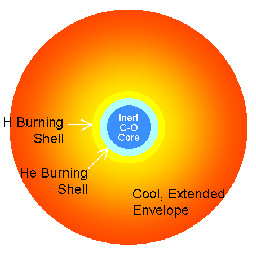
Outside:
- Star grows rapidly in radius and cools
Climbs the Giant Branch again, but at a higher effective Temperature
than the Giant Branch, so it ascends with a bluer color, putting it
slightly to the left of the original Giant Branch on the H-R Diagram:
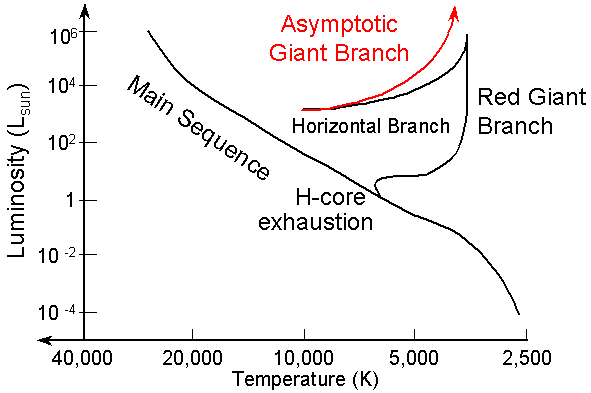
The star becomes an Asymptotic Giant Branch Star
He burning is very temperature sensitive: Triple-alpha fusion
rate ~ T40!
Consequences:
- Small changes in T lead to
- Large changes in fusion energy output
Star experiences huge Thermal Pulses that destabilize the
outer envelope.
Core-Envelope Separation
Rapid Process: takes ~105 years
Outer envelope gets slowly ejected (fast wind)
C-O core continues to contract:
- With the weight of envelope taken off, the core heats up less
- It never reaches the Carbon fusion ignition temperature of 600 Million K
Core and Envelope separate physically.
Planetary Nebula Phase
Expanding envelope forms a nebula around the contracting C-O
core:
- Ionized and heated by the hot central core.
- Expands away to nothing in ~104 years.
The star briefly becomes host to a Planetary Nebula
The hot C-O core is exposed, and moves quickly to the left on the H-R Diagram
at nearly constant luminosity and increasing temperature.
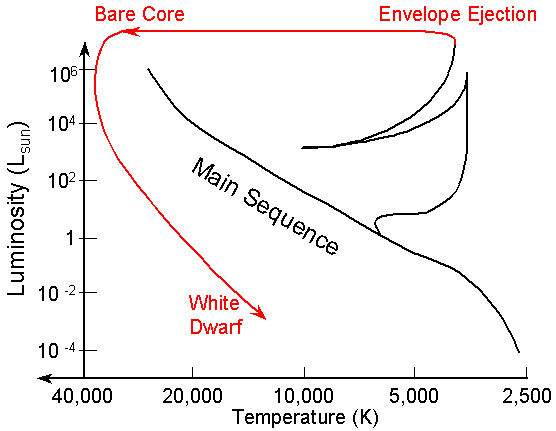
Images of Planetary Nebulae
Planetary nebulae are among the most beautiful objects in the sky. Below
are links to PNe pretty-picture sites:
Enough, already, back to the story...
Core Collapse to White Dwarf
The contracting C-O core becomes so dense that a new gas law takes
over...
Degenerate Electron Gas:
- Pressure becomes independent of Temperature
- P grows rapidly & soon counteracts Gravity
Collapse halts when R ~ 0.01 Rsun (~ Rearth)
- Degenerate core becomes a White Dwarf
We will learn more about White Dwarfs in Unit 3.
Return to [
Unit 2 Index
|
Astronomy 162 Main Page
]
Updated: 2006 January 21
Copyright © Richard W. Pogge, All Rights
Reserved.










